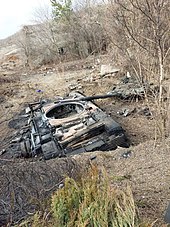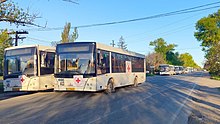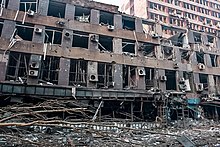Siege of Mariupol
During the Russian siege, the Red Cross described the situation in Mariupol as "apocalyptic" while Ukrainian authorities accused Russia of engineering a major humanitarian crisis in the city.
[1][62][63][64][65][55] Some Western reports described the siege as a pyrrhic[66][67] or symbolic[68] Russian victory, with others noting that the humanitarian impact of the takeover was a "reputational disaster" for Russia.
Tensions erupted into the war in Donbas in early May, and during the unrest, militiamen of the separatist and Russian-backed Donetsk People's Republic (DPR) took control of the city and forced Ukrainian troops to abandon it during the first battle for Mariupol.
[85] One of the most instrumental groups for the recapture and subsequent defenses of Mariupol was the Azov Battalion, a Ukrainian volunteer militia, controversial for its openly neo-Nazi and ultranationalist members.
[89] As one of Vladimir Putin's stated goals for the invasion was the "denazification" of Ukraine, Mariupol represented an important ideological and symbolical target for the Russian forces.
[123] Eduard Basurin, the spokesman for the DPR militia, formally called on the besieged Ukrainian forces in Mariupol to surrender or face "targeted strikes".
[140] On 7 March, the ICRC Director of Operations stated that humanitarian corridor agreements had only been made in principle, without the precision required for implementation, needing routes, times and whether goods could be brought in to be agreed.
[154][155] The Ukrainian Ministry of Internal Affairs said that the National Guard of Ukraine had damaged several Russian armored vehicles with artillery strikes during the day.
[176] An order by Russia's Ministry of Defence to surrender, lay down arms and evacuate the city was submitted on 20 March, requesting a written response by 02:00 UTC the next day.
[171] Two Ukrainian Mil Mi-8 helicopters flew into Azovstal as part of "Operation Air Corridor", carrying a special forces team with crates of Stinger and Javelin missiles, as well as a satellite internet system.
[179] Ukraine claimed 85 seriously wounded soldiers were evacuated as part of "Operation Air Corridor"[179] during seven missions to the Azovstal plant to resupply or deliver reinforcements using some 16 Mi-8s, in pairs or fours, two of which were shot down, along with the rescue helicopter, according to Major General Kyrylo Budanov.
[209] During the night between 11 and 12 April,[210] Baranyuk led the 36th Separate Marine Brigade in an attempt to break out of the Russian encirclement at the Illich steel plant to the north.
[223] Ukrainian military expert Oleg Zhdanov claimed that by this point the Russian 810th Guards Naval Infantry Brigade, originally sent from Feodosia, had suffered extremely heavy losses during the siege, to the extent of being "destroyed twice.
Ukrainian Deputy Defence Minister Hanna Maliar said: "Thanks to the defenders of Mariupol, Ukraine gained critically important time to form reserves and regroup forces and receive help from partners.
[276] According to Russian sources, the last defenders surrendered on 20 May, among them Lieutenant Colonel Prokopenko, Major Volynskyi and Captain Svyatoslav Palamar, deputy commander of the Azov Regiment.
[293] According to the head of the patrol police of Mariupol Mykhailo Vershinin, Kohut helped with the defense of the city from Russian invaders and coordinated public utilities actions under intense shelling.
[297] On 28 April 2022, the Rospotrebnadzor issued a 40-paragraph resolution calling for additional measures to be taken in regards to drinking and waste water, especially in places which had become locations for Ukrainian refugees (specifically Belgorod, Bryansk, Kursk, Rostov and Voronezh Oblasts), as well as providing information to citizens about cholera by 1 June 2022.
[301] In May 2023, the Ukrainian military began launching long-range missile strikes on Russian positions in Mariupol, who had started to turn the city and the surrounding villages into a military-logistics hub.
[149] On 6 March, Petro Andryushchenko, advisor to the mayor of Mariupol, reported that people were "drinking from puddles in the streets" due to the loss of running water in the city caused by days of around-the-clock Russian shelling and bombing attacks.
[335] On 14 March, another spokesman for the ICRC announced that "hundreds of thousands" of people in the city were "facing extreme or total shortages of basic necessities like food, water and medicine.
"[336] On 15 March, Ukraine's Deputy Prime Minister Iryna Vereshchuk accused Russian forces of taking around 400 civilians hostage after capturing a hospital in the city.
[339] On 21 March, CNN reported that an official in Mariupol said that people are afraid, due to the constant bombing and shelling, to leave their underground shelters even to obtain food and water, meaning they were trying to drink less and eat less.
[345] On 25 March, Russian Colonel-General[346] Mikhail Mizintsev was accused by Ukrainian authorities of ordering the bombings of both the Mariupol Children's and Maternity Hospital and the city theatre where 1,200 civilians were sheltering.
[363] A satellite image taken by Maxar Technologies on 14 March showed that the Russian word for "children" was written in large white letters on the pavement in both the front and the back of the theatre, which would make it clear that civilians were sheltering inside.
[121] Satellite photos of Mariupol taken the morning of 9 March taken by Maxar Technologies showed "extensive damage" to high-rise apartments, residential homes, grocery stores and other civilian infrastructure.
"[373] On the same day it reported that it had obtained drone footage showing "a vast extent of damage, with fire and smoke billowing out of apartment blocks and blackened streets in ruins.
"[374] On 18 March, Lieutenant General Jim Hockenhull, Chief of Defence Intelligence for the United Kingdom (UK), described "continued targeting of civilians in Mariupol".
[383] As of 2022, according to experts, it was too soon to say what exactly had happened,[384] UK and Ukrainian officials said that they suspected the use of white phosphorus, which is not typically regarded as a chemical weapon in international law.
[381] Associated Press staff member Mstyslav Chernov and freelancer Evgeniy Maloletka, working for AP, stayed in Mariupol from late February until 11 March.
[394] The Guardian observed in a piece on Mariupol published after the Russian attack on the Mariupol maternity ward that "Entire settlements reduced to rubble, attacks on civilian targets and the bombing of refugee exit routes were all part of Moscow's brutal Syria campaign",[395] while the Washington Post under the headline "Russia's Ukraine war builds on tactics it used in Syria, experts say" related the effects on the civilian population as "dwindling food supplies.


3 March 2022

3 March 2022
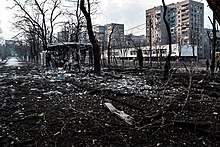
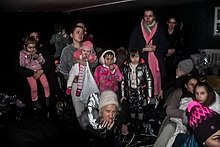
12 March 2022
